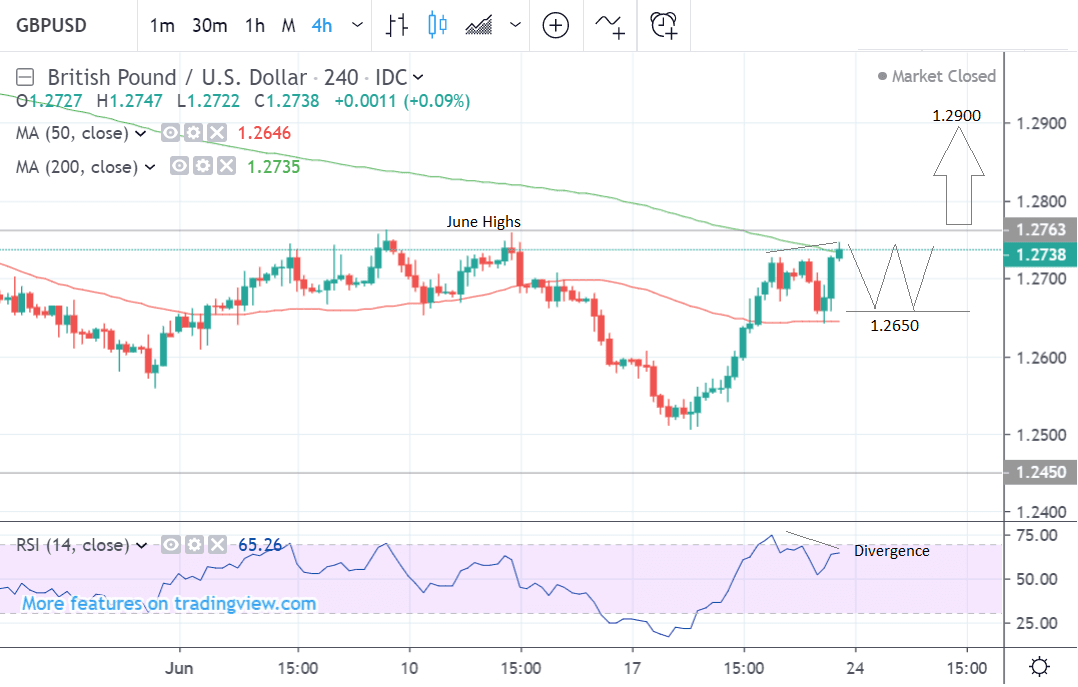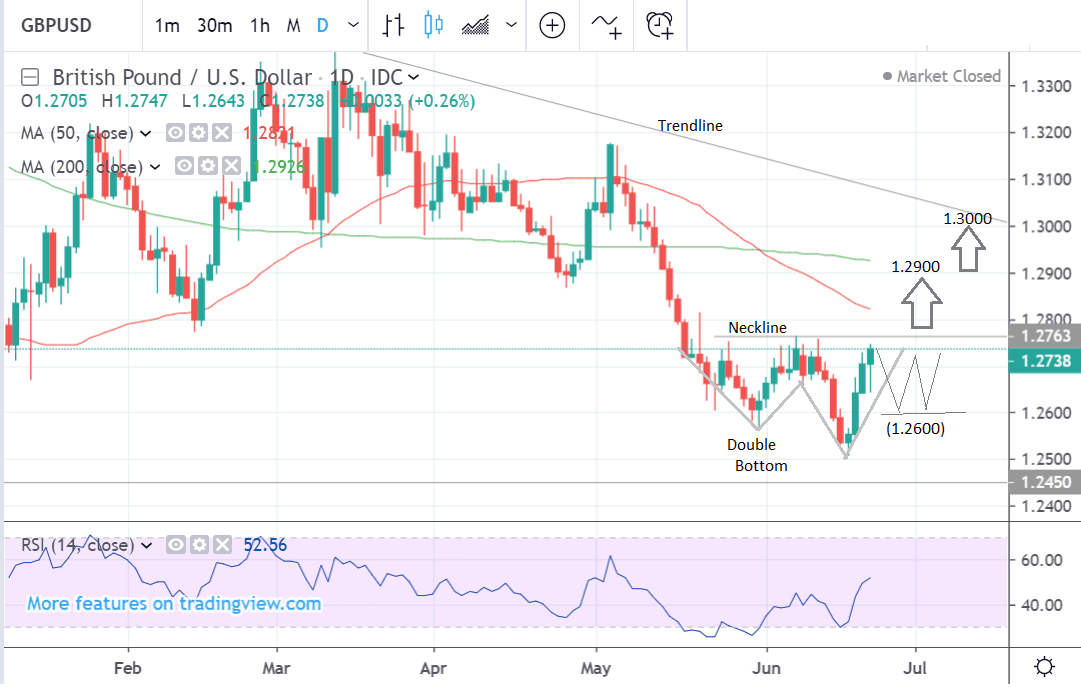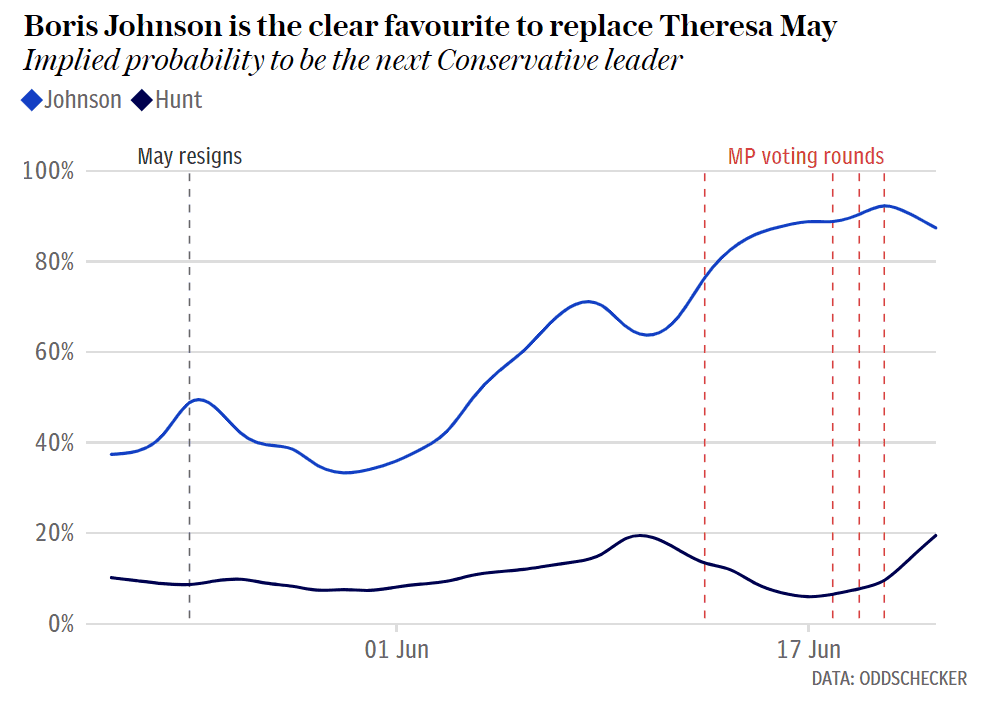Pound-to-Dollar Rate Week Ahead: Surge at End of Previous Week Could Extend

Image © Adobe Images
- GBP/USD rises up to key June highs
- A break above would give the green light to more gains
- Pound impacted by Brexit fears; Dollar by PCE reading
The Pound-to-Dollar rate will be trading at around 1.2738 at the start of the new week, after rising 1.2% in the previous week. Studies of the charts suggest that the exchange rate is likely to continue rising over the next five days.
The 4 hour chart shows the pair has risen strongly since basing at the June 18 lows. It has surged over 2 whole cents in only 3 days.
Recently, however, the exchange rate has started diverging with the RSI momentum indicator in the lower panel, and this is a bearish sign the pair could rotate and turn lower.
Whilst not necessarily a reversal sign, the divergence indicates the pair will probably pull-back over the next few sessions and unfold sideways between roughly the mid 1.26s and 1.27s for a time until it eventually breaks higher.
The pair has now almost reached the key June 7 highs at 1.2760. If it breaks above this level on a closing basis it would provide a critical bullish signal and suggest a continuation up to a target at 1.2900.
The 4 hr chart is used to assess the trend over the short-term, which means the next 5 days.
The daily chart shows the pair completing a possible double bottom reversal pattern, which indicates the likelihood of more upside to come.
Again, the June highs at 1.2760, are critical: a break above them would see the upside promise of the double bottom pattern realised, and the fulfillment of a probable move all the way up to 1.2900.
The June highs are actually the neckline of the double bottom, which is the level which connects the peaks of the pattern.
There is a suggestion the exchange rate could go sideways for a time before it breaks higher.
The second trough of the double bottom is much lower than the first which could indicate it is the 'head' of a more complex inverse head and shoulders pattern, and it could have further to unfold.
If so, then it will probably go sideways for a time, oscillating between 1.2760 and 1.2600.
The daily chart is used to provide an indication of the medium-term outlook which includes the next week to a month ahead.
The weekly chart shows that a strong bullish candle formed last week and this could be a sign of a recovery.
In the long-term the pair is likely to continue higher to a target at 1.3000 eventually where it will encounter a major trendline.
From there it is likely to fall back down to support at the June highs and the 1.2800 level again.
The weekly chart is used to give an idea of the longer-term outlook, which includes the next few months.
Time to move your money? Get 3-5% more currency than your bank would offer by using the services of foreign exchange specialists at RationalFX. A specialist broker can deliver you an exchange rate closer to the real market rate, thereby saving you substantial quantities of currency. Find out more here.
* Advertisement
The Dollar: What to Watch
The main release in the week ahead for the U.S. Dollar is the Personal Consumption Expenditure (PCE) Index, which is an important gauge of inflation.
PCE is expected to show a 1.6% and 0.2% rise on a yearly and monthly basis respectively, when it is released on Friday, at 13.30 BST.
The PCE is important because it is the favoured inflation metric of the Federal Reserve (Fed), who set base U.S. interest rates; and these have a major impact on the Dollar.
If PCE rises more than expected it will increase chances the Fed will not go ahead and cut interest rates as is currently expected based on commentary from their last meeting. This will push up the Dollar.
If the PCE undershoots it will increase the probability the Fed will cut rates and have a negative impact on the Dollar.
Lower interest rates weaken the Dollar by reducing net inflows of foreign capital because it makes the U.S. a less attractive place for foreign investors to park their money.
Analysts at Wells Fargo note strong spending in March and April which supports a robust PCE result in May. This suggests the probability that the metric will either hit or beat forecasts.
“The real spending level in April was up an annualized 2.2% above the Q1 average and supports our call for strong consumer spending growth in Q2. This solid spending gain will provide significant underlying support to Q2 GDP growth, which is likely to be restrained by a wider trade deficit and less inventory building,” says Wells Fargo.
Other key data releases in the week ahead for the Dollar are durable goods orders at 13.30 on Wednesday; pending home sales at 15.00 on Thursday; new homes sales and consumer confidence at 15.00 Tuesday, and commentary from Fed officials.
An important macro event for the U.S. Dollar is likely to be the G20 meeting, which starts on Friday, June 28, although the effects are unlikely to be fully absorbed until the following week.
The Dollar is likely to act as a safe-haven in relation to the G20. The main focus will be trade tensions between the U.S. and China.
If relations improve, as many analysts seem to believe is possible, the Dollar could falter, and vice versa if they worsen.
The Pound: What to Watch
The leadership race may take a back seat as a Sterling driver in the coming week as the two remaining candidates Boris Johnson and Jeremy Hunt will be busy campaigning around the country, and the final results are not expected until July 22.
Johnson is the front-runner by a large margin and bar any major revelations which would make him unsuitable for the job he is likely to win the race and become the next Prime Minister.
Any details on Johnson's Brexit strategy could prove to be important for near-term Sterling direction.
Part of the reason Sterling has weakened over recent weeks is the growing likelihood this will be the case: Johnson is a hard-Brexiteer who could potentially take the UK out of the EU without a deal. However, such a strategy could almost certainly a handful of defections by Conservative MPs opposed to 'no deal', which would ultimately see the Government unable to govern, in turn inviting a General Election.
A General Election taking place over coming months is another source of uncertainty that should see Sterling remain under pressure.
Sterling has also fallen on the so-far unyielding response of EU officials to hints Johnson wants to renegotiate. This has increased the chances of a stalemate and the UK simply flopping out without a deal on October 31.
Another possible factor which could impact on the Pound is the inflation report hearing on Wednesday, June 26.
This involves the Governor of the Bank of England (BOE) Mark Carney and other BOE officials taking questions from the Parliamentary treasury select committee on the outlook for inflation and the economy.
Although most of their answers will be highly conditional on what sort of Brexit the UK has, they could still impact the Pound.
The BOE uses inflation and other economic data to decide on the level at which to set interest rates, and these have a direct influence on the Pound.
If growth and inflation rise the BOE tend to put up interest rates which appreciates the Pound. Higher interest rates attract greater inflows of foreign capital and vice versa for lower interest rates.
The second estimate of Q1 GDP is forecast to show growth unchanged at 1.8% year-on-year (yoy) and 0.5% (mom) when it is released on Friday on 9.30 BST. Only a revision would impact Sterling.
Other data out in the week ahead is the current account and business investment, which are both scheduled for release at the same time as GDP; and gross mortgage approvals, out at 9.30 on Wednesday.
Time to move your money? Get 3-5% more currency than your bank would offer by using the services of foreign exchange specialists at RationalFX. A specialist broker can deliver you an exchange rate closer to the real market rate, thereby saving you substantial quantities of currency. Find out more here.
* Advertisement








